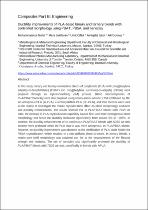 ResearchSpace
ResearchSpace
Ductility improvements of PLA-based binary and ternary blends with controlled morphology using PBAT, PBSA, and nanoclay
JavaScript is disabled for your browser. Some features of this site may not work without it.
- ResearchSpace
- →
- Research Publications/Outputs
- →
- Journal Articles
- →
- View Item
| dc.contributor.author |
Nofar, M

|
|
| dc.contributor.author |
Salehiyan, Reza

|
|
| dc.contributor.author |
Ciftci, U

|
|
| dc.contributor.author |
Jalali, A

|
|
| dc.contributor.author |
Durmus, A

|
|
| dc.date.accessioned | 2020-03-19T12:13:34Z | |
| dc.date.available | 2020-03-19T12:13:34Z | |
| dc.date.issued | 2020-02 | |
| dc.identifier.citation | Nofar, M., Salehiyan, R., Ciftci, U., Jalali, A. & Durmus, A. 2020. Ductility improvements of PLA-based binary and ternary blends with controlled morphology using PBAT, PBSA, and nanoclay. Composites Part B: Engineering, vol. 182, pp. 1-13 | en_US |
| dc.identifier.issn | 1359-8368 | |
| dc.identifier.issn | 1879-1069 | |
| dc.identifier.uri | https://doi.org/10.1016/j.compositesb.2019.107661 | |
| dc.identifier.uri | https://www.sciencedirect.com/science/article/pii/S1359836819335474 | |
| dc.identifier.uri | http://hdl.handle.net/10204/11368 | |
| dc.description | Copyright: 2019 Elsevier. Due to copyright restrictions, the attached PDF file contains the abstract version of the full-text item. For access to the full-text item, please consult the publisher's website. The definitive version of the work is published in the Composites Part B: Engineering, vol. 182, pp. 1-13 | en_US |
| dc.description.abstract | In this study, binary and ternary immiscible blends of polylactide (PLA) with poly[(butylene adipate)-co-terephthalate] (PBAT) and poly[(butylene succinate)-co-adipate] (PBSA) were prepared through an injectionmolding (IM) process. Blend nanocomposites of PLA/PBAT/nanoclay were also prepared using a twin-screw extruder (TSE) followed by IM. An amorphous PLA (A-PLA), a semicrystalline PLA (SC-PLA), and their mixture were used as the matrix to investigate the matrix crystallization effect on blend morphology evolution and ductility enhancements. The results showed that in PLA/PBAT blends with 75/25 wt ratio, the increase in PLA crystallization capability caused finer and more homogenous blend morphology and hence the ductility increased significantly from around 5% to ~205%. In contrast, the ductility enhancements of co-continuous PLA/PBAT blends with 50/50 wt ratio became more profound when the PLA matrix was more amorphous. In PLA/PBSA blends, however, no ductility improvement was observed as the vitrification of PLA could hinder the PBSA crystallization which resulted in a non-uniform blend structure. In ternary blends, a matrix-core shell morphology was obtained and led to the improvements of the flexural strength and modulus. The use of nanoclay also significantly promoted the ductility of PLA/PBAT blends with 75/25 wt ratio, specifically in blends with APLA. | en_US |
| dc.language.iso | en | en_US |
| dc.publisher | Elsevier | en_US |
| dc.relation.ispartofseries | Workflow;23063 | |
| dc.subject | Crystallization | en_US |
| dc.subject | Nanocomposite | en_US |
| dc.subject | Mechanical properties | en_US |
| dc.title | Ductility improvements of PLA-based binary and ternary blends with controlled morphology using PBAT, PBSA, and nanoclay | en_US |
| dc.type | Article | en_US |
| dc.identifier.apacitation | Nofar, M., Salehiyan, R., Ciftci, U., Jalali, A., & Durmus, A. (2020). Ductility improvements of PLA-based binary and ternary blends with controlled morphology using PBAT, PBSA, and nanoclay. http://hdl.handle.net/10204/11368 | en_ZA |
| dc.identifier.chicagocitation | Nofar, M, Reza Salehiyan, U Ciftci, A Jalali, and A Durmus "Ductility improvements of PLA-based binary and ternary blends with controlled morphology using PBAT, PBSA, and nanoclay." (2020) http://hdl.handle.net/10204/11368 | en_ZA |
| dc.identifier.vancouvercitation | Nofar M, Salehiyan R, Ciftci U, Jalali A, Durmus A. Ductility improvements of PLA-based binary and ternary blends with controlled morphology using PBAT, PBSA, and nanoclay. 2020; http://hdl.handle.net/10204/11368. | en_ZA |
| dc.identifier.ris | TY - Article AU - Nofar, M AU - Salehiyan, Reza AU - Ciftci, U AU - Jalali, A AU - Durmus, A AB - In this study, binary and ternary immiscible blends of polylactide (PLA) with poly[(butylene adipate)-co-terephthalate] (PBAT) and poly[(butylene succinate)-co-adipate] (PBSA) were prepared through an injectionmolding (IM) process. Blend nanocomposites of PLA/PBAT/nanoclay were also prepared using a twin-screw extruder (TSE) followed by IM. An amorphous PLA (A-PLA), a semicrystalline PLA (SC-PLA), and their mixture were used as the matrix to investigate the matrix crystallization effect on blend morphology evolution and ductility enhancements. The results showed that in PLA/PBAT blends with 75/25 wt ratio, the increase in PLA crystallization capability caused finer and more homogenous blend morphology and hence the ductility increased significantly from around 5% to ~205%. In contrast, the ductility enhancements of co-continuous PLA/PBAT blends with 50/50 wt ratio became more profound when the PLA matrix was more amorphous. In PLA/PBSA blends, however, no ductility improvement was observed as the vitrification of PLA could hinder the PBSA crystallization which resulted in a non-uniform blend structure. In ternary blends, a matrix-core shell morphology was obtained and led to the improvements of the flexural strength and modulus. The use of nanoclay also significantly promoted the ductility of PLA/PBAT blends with 75/25 wt ratio, specifically in blends with APLA. DA - 2020-02 DB - ResearchSpace DP - CSIR KW - Crystallization KW - Nanocomposite KW - Mechanical properties LK - https://researchspace.csir.co.za PY - 2020 SM - 1359-8368 SM - 1879-1069 T1 - Ductility improvements of PLA-based binary and ternary blends with controlled morphology using PBAT, PBSA, and nanoclay TI - Ductility improvements of PLA-based binary and ternary blends with controlled morphology using PBAT, PBSA, and nanoclay UR - http://hdl.handle.net/10204/11368 ER - | en_ZA |





